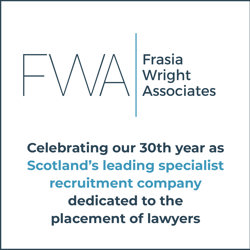How do existing leaders successfully navigate a merger?
Chris Harte, previously Chief Executive of Morton Fraser, is now CEO of the newly created Morton Fraser MacRoberts LLP (MFMac), while Neil Kennedy, Managing Partner of MacRoberts, is now Chief Operating Officer. Their first joint undertaking was realising the scale of the challenge involved in the continual need to juggle the demands of the merger project while ensuring that both firms kept their eye on the ‘day job’.
Becoming Scotland's largest independent law firm
“These are two successful businesses coming together and we couldn’t let our client services miss a beat,” says Chris. “Previously, we used to catch up from time to time and often discussed how we saw the future. We were both pursuing a similar strategy to be Scotland’s leading law firm, and it started to make sense that we should do it together so we began exploring the possibility of merging.”
Neil says: “A project this size is complicated, with many layers and different stakeholders. He points out that they had networks in common but had never worked together previously, so good communication was vital from the outset. “We first met when I became Managing Partner of MacRoberts and the benefits of working together soon became obvious, especially when you consider the combination of talents and knowledge we acquire through merging. MacRoberts has strengths in energy and infrastructure, while Morton Fraser has a wider and larger client base in corporate real estate and housebuilding. Clients of both firms will now have access to a range of complementary services, including advice on pensions, share schemes, corporate tax, intellectual property and immigration law.”
"Significant undertaking"
The period between the merger being introduced to both partner groups and it going live was relatively short at around nine to ten months. “Executing a merger of this scale is obviously a significant undertaking and we had to be very joined up on communications throughout the process,” says Chris. “It was hugely important to communicate in a co-ordinated, consistent way and to ensure that everyone was receiving the same information, at the same time. So, for example, the merger announcement was made at the same time in each legacy firm and we continued to share detailed FAQs at different stages, so that both firms received consistent and helpful information. We followed this up with various supporting documents that had been jointly prepared, including an overarching vision statement, setting out the high-level rationale for the merger and the benefits we believe it will deliver. We maintained this ethos all the way through to our joint presentations to our people at our ‘go-live’ launch events in November.”
Trust and leadership
“We very quickly built up a relationship of trust, which helped carry us through the various stages of the merger process till we reached the official launch,” says Neil. “We certainly have straightforwardness in common in our leadership styles, which has helped us during the merger. Transparency is another key thing. We both share the view that open and consistent communication right across the business is vital but especially during a merger process.”
Chris says: “I'd describe my leadership style as open and straightforward too – but you'd be better asking my colleagues. While we obviously have differing experience and strengths, once we started discussing our values and ambitions we realised our firms were much more complementary than at first sight. We now have the ability to do more, which comes with scaling up, and it also allows us to be more focused and strategic in developing our talent.”
“We made many of the big key discussions very early on,” says Neil. “We wanted to avoid leadership elections so we had a very open chat about ambitions, strengths and success, looking at that in relation to job descriptions. I think in allocating both roles we’re playing to our respective strengths and looking at the best decisions for the new business. We’re also both supported by great colleagues right across the business so it’s more than just about us.”
With nearly 500 staff now, 250 of them solicitors, Chris and Neil knew it was vital to keep them abreast of the merger before it became public. The merger of two comparable sized firms is also relatively rare – in most situations of this kind it tends to be smaller firms being taken over by much larger organisations.
“The first people to hear about this had to be our people – staff and clients – and we’re always talking to clients to find out what they want and need, what’s in the pipeline for them and how we can assist,” says Neil. “We got really good early feedback from clients who knew both firms or indeed already used both our firms, and it was clear that they could see all the positives in us merging. Internally, people were buying into the vision, I think because of the way we introduced our plans.”
Internal enthusiasm
Both of them were keen to have detailed plans in place before making the internal announcement and feel that paid off in terms of staff response. “They were equally enthusiastic, especially once they realised that the merger was about opportunity,” says Chris. “Duplication in some roles required considerable discussion about bringing teams together, as well as being abreast of who would be communicating with different clients. The result was a real team effort in effective comms and we’ve also had positive feedback from our peers to date. The market for legal services in Scotland is as dynamic and competitive as it has ever been, and we don’t see that changing at any point soon.”
The question of how they’ll work together is one they’re both expecting to be asked, but the months of hard work involved in preparing the merger has stood them in good stead. “Anything worthwhile takes effort and this was two large commercial entities coming together, so the idea that we agreed all the time is not realistic,” says Chris. “There were issues we had to find our way through and disagree without falling out.”
“That gives you confidence,” says Neil. “We’ll continue to be tested but we have trust, confidence and empathy, so we’re a cultural fit. Already, we have strong evidence that we’re working together well, the commitment shown by our colleagues has been fantastic and clients are happy. We’ve created a new style of firm within the top tier of independent Scottish law firms with MFMac and become the joint-third largest independent firm by number of solicitors. Now we’re aiming to become Scotland’s leading law firm.”






